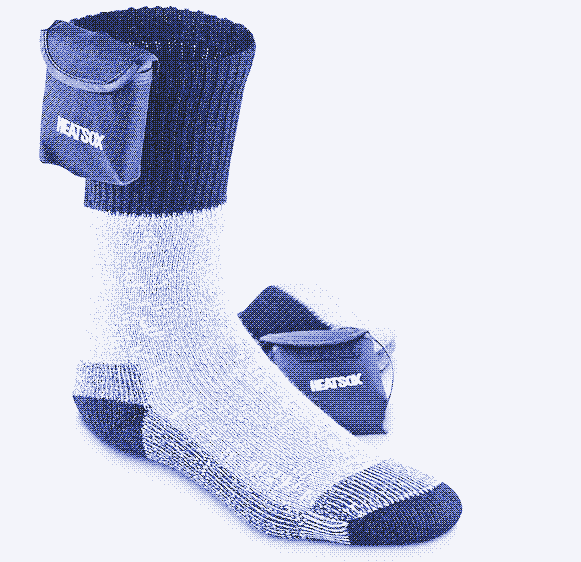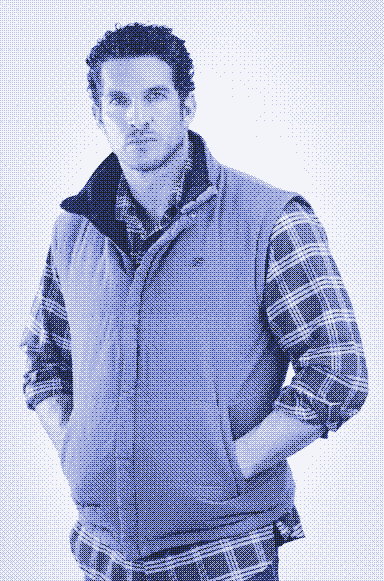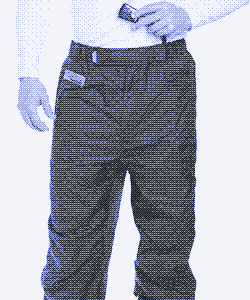
As we wrote two years ago, insulation of the body is more energy efficient than insulation of living space. Because of its excellent insulating properties, modern thermal underclothing makes it possible to burn the heating at much lower temperatures without sacrificing comfort or sex appeal. The potential energy savings are huge, and the costs are almost nil.
This low-tech insulation strategy can also be applied to heating the body. In use since World War Two, electrically heated clothes have become more effective and comfortable in recent years. While their use outdoors increases energy consumption, heated clothes have the potential to save massive amounts of energy indoors.
World War Two
Electrically heated clothing is used by soldiers, adventurers, hunters, winter sports enthusiasts, bikers and construction workers 1. Heated leather jackets were already used by pilots in World War Two. Bikers have used the technology for decades, using the battery of their motorbikes to supply the required energy.
The arrival of compact lithium-ion batteries has increased the performance and diversity of electrically heated clothing. There are now more types of heated clothes on the market: jackets, vests, pants, socks, underclothing, baselayers, sweaters, scarfs, shoes and gloves. Some have even become fashionable.
The energy for these garments is supplied by one or two relatively small and light batteries, hidden in a special pocket, which supply the lucky owner with some five hours of warmth. Some brands offer the possibility to plug in heated gloves or socks in a heated pants or jacket, so that they don’t need a separate battery.
Carbon Fibres
Also new is the use of carbon fibres as a heating element. This material is flexible and can be inserted anywhere in the clothes without creating discomfort for the wearer. Carbon fibres are replacing embedded heating wires, which are rigid and heavy, break easily, and require more energy. Making use of low voltages for safety, electrically heated clothing comes with a button on the outside which enables the regulation of the heating system.

Unfortunately, electrically heated clothing doesn’t save energy when it is used outdoors. Like most technologies that increase comfort, it increases energy consumption. The big advantage for people who work or play outdoors is that heated clothing keeps them warm during breaks in activity, when body temperature can decrease quickly.
Effective and Efficient
When used as a heating strategy indoors, however, electrically heated clothing is as sustainable as it can get. A fully heated wardrobe – pants, socks, underclothing, shirt and vest—has an energy output of 100 watts maximum. There’s no need for the heating elements to get very hot because they remain close to the skin. An electric heater of that calibre used for space heating brings little comfort, even if it heats a very small room.

Using electrically heated clothing we could be more comfortable at even lower indoor temperatures than when using thermal clothing (which already offered heating till near-freezing conditions). Another advantage of electric clothes is that you need less volume and weight to stay comfortable. This effectiveness and efficiency of heated clothes has been confirmed by scientific research 2.
Electrically heated clothing can also be used without activating the heating elements—the good insulation of the garments traps body heat, as with thermal clothes. In this sense, heated clothing is similar to a bicycle with an electrically assisted motor. Unlike electric cars or smartphones, the clothes don’t become useless when the battery dies.
Wired or Wireless?
The only unsustainable feature of electrically heated clothing is its use of batteries. A wireless energy supply is very practical, but it would be perfectly possible to connect electrically heated clothes directly to the grid, just as you would do with your phone and laptop. It would function like an electric blanket or sleeping bag. Since many of us are sedentry, this is not as far-fetched as it may seem.
You can also make your own electrically heated clothing.
Reactions
To make a comment, please send an e-mail to solar (at) lowtechmagazine (dot) com. Your e-mail address is not used for other purposes, and will be deleted after the comment is published. If you don’t want your real name to be published, sign the e-mail with the name you want to appear.
Reactions
wallebot
En este caso no necesitas baterias electricas, tambien se pueden usar baterias termicas.
Mezclando cloruro calcico con agua se produce calor. Se usa en cafes autocalentables.
Una solucion de acetato sodico hipersaturada se puede calentar. Permanece en un estado estable aunque se enfrie, pero con un golpe u otro evento empieza a cristalizar y generar calor seguro a unos 50º.
No conozco otras densidades energeticas, pero la Cal viva genera 3 veces mas energia que una bateria de plomo al convertirse en carbonato calcico.
Tal vez la oxidacion controlada puede ser otro fuente de calor.
Existian unos mecheros cataliticos sin llama los calentabas y te podias calentar las manos si te protegias con un pañuelo o tela.
Los posos de cafe tambien generan bastante calor durante dias o mas. Si se les añade fertilizante nitrogenado se reactivan y calientan.
Pero generan humedad y necesitan respirar.
Los submarinistas que utilizan regeneracion de aire, al elimnar el CO2 obtienen calor con una reaccion quimica con la cal sodada.
Roddy Pfeiffer
I am not aware of any health hazards from superinsulated houses other than humidity and stale air from lower ACH’s (air changes per hour). These issues were solved 30 years ago nu air exchangers. they do not have complex control systems nor use more than a negligible amount of electricity. They do not have any of the problems you mention in your post. Please do not lump several types of home systems together and dismiss them all because some of them have problems. There are passive solar houses, passive houses, geothermal houses. etc. Superinsulated refers only to a house having a large amount of insulation to achieve savings. They use the ductwork found in central A/C to move the air through an air exchanger. No more maintenance is required than any central air system.
-
AN ELECTRIC SHEET (THIN ELECTRIC BLANKET) WORKS GREAT IF YOUR ACTIVITIES ARE LOCALIZED TO THE LENGTH OF THE CORD. AS FOR GETTING TANGLED UP IN THE CORD, PEOPLE HAVE USED ELECTRIC DRILLS FOR DECADES AND ROPE FOR THOUSANDS OF YEARS . IT’S JUST A MATTER OF GETTING USED TO IT.
Dorinda Troutman
How is this clothing cleaned? If it can be washed like normal clothing that would be great. If it needs to be dry cleaned, that too would be a negative on the environment.
Josh B.
Even more low-tech is to simply stock up on wool sweaters and socks, long-johns, flannels, etc. The benefits are more than financial, as hanging out around the house in cozy clothes is psychologically beneficial as well. Imagine how comfy it would be to spend all day at work with your flannels on underneath your suit or dress!
Kris De Decker
Patricia, you should read the article on thermal underclothing, which explains the science of thermal comfort.
http://www.lowtechmagazine.com/2011/02/insulation-first-the-body-then-the-home.html
If you keep your body warm enough, your hands, ears and nose will be fine.
picard
At which temperature in your house are you still comfortable with this (low) technologie? 15°C? 10°C? 5°C? 0°C? I guess that you will have a threshold. Beyond a low temperature you won’t fill very well anymore, have you got any data on this?
“Superinsulated houses are causing many health concerns.” have you got any data on this it sounds quite interesting.
Last thing i haven’t seen you discuss (maybe i missed it) in your post about house insulation, the most efficient way to decrease the energy use for insulation would be decrease of the surface per persone!
Himbeerkuchen
@ Kris,
thanks a lot. In any case, what I keep appreciating about Lowtechmagazine is the continued and radical out-of-the-box thinking that the articles show. Not everything may be for everybody, but we all need to question why we do things the way we do them. Lots of behaviours of ours that have an impact on the environment or on other people could be changed, and with many of them we would not even have to suffer from reduced comfort, I believe. Keep up the spirit!
Rakaziel
You do not take into account indoor plants. While it would be possible to switch to decorative plants that survive the seasonal outside temperatures, this approach still collides with effective vertical farming (keeping things warm enough for three harvests a year).
Patricia Mathews
So I heat my clothing and keep the house cold. Next thing I know my ears and nose have turned red, my nose is dripping and running, and then they turn white. Frostbite time! Meanwhile my fingers have cracked and split and are now bleeding.
And working in electrically wired gloves? You would not be able to count the typos!
No, thank you.
Leo
Low tech? Electricity is the worse way to heat.
IMHO oil heaters are betters, far bigger energy capacity… like zippo hand warmer.
You can put it where you want/need, 12 hours heating! why do not imagine a copper conduction repartition.
johny
The real test comes when getting naked to go to bed, taking a shower, eating in a cold environment then visiting the cold toilet. It would work great in a work setting where one has to work outdoors in -30 or less with extreme windchill factors.
Earthling
Kris, “If you keep your body warm enough, your hands, ears and nose will be fine.”
That may depend on age, I’m 73, and my hands get cold when my body is toasty.
BTidwell
I suppose the key thing is how one defines comfort. Some people will put up with a lot that others might find uncomfortable because they have higher priorities, like “saving energy.” During the several years I lived in the NE USA, I had to dress very warm for winters which hover around, if not considerably below, freezing for almost four months. Since I didn’t tend to completely change clothes every time I came into my house,I found I could set the thermostat around 62f, rather than a usual 68f. Anything much cooler than that was noticeably chilly, which is unacceptable to me. I don’t like air that feels cold, even if I’m not shivering. Anything below 55f made hard surfaces in the house cold to touch and made disrobing for bed or bath very uncomfortable. I will not lay in bed dreading having to get out of the warm covers in the morning as long as central heat is an option. I have to disagree that warm clothes make hats and gloves unnecessary. Any medical professional will tell you that those are key to avoiding hypothermia. You loose more heat from your head than any other body part, thus the reason for sleeping caps in days of old. At temps below 40f my fingers absolutely get cold and no amount of warm sweaters help.
Whatever
Roddy Pfeiffer > Heated clothes require an electric element close to the skin and subjects the wearer to unnecessary electromagnetic radiation.
What are reliable sources that would show that electromagnetic radiation causes health problems?
www.who.int/peh-emf/about/WhatisEMF/en/index1.html
gareth
Roddy Pfeiffer - very limited evidence for any reasonable amounts of electromagnetic radiation and harm, and many orders of magnitude less concern for DC than AC.
My electric innersoles use 5V DC and no more than 500mA each (USB battery), compared to the various unnamed chemicals in many cleaning products, ash fallout from coal power stations, with radiation, fire fighting foam residuals in our water etc etc - I think I am very comfortable with the risk of electric shoes and socks.
Just one point on tightly enclosed houses, in some areas (usually granite) this is a serious health concern due to the build up of Radon gas from the ground, leading to lung cancer. Locally, we have enforced standards of vents etc in houses in certain areas. Be careful.